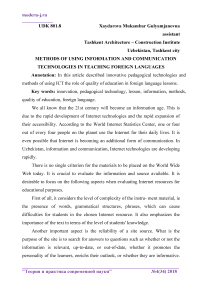Methods of using information and communication technologies in teaching foreign languages
Автор: Xaydarova M.G.
Журнал: Теория и практика современной науки @modern-j
Рубрика: Основной раздел
Статья в выпуске: 4 (34), 2018 года.
Бесплатный доступ
In this article described innovative pedagogical technologies and methods of using ICT the role of quality of education in foreign language lessons.
Innovation, pedagogical technology, lesson, information, methods, quality of education, foreign language
Короткий адрес: https://sciup.org/140272982
IDR: 140272982
Текст научной статьи Methods of using information and communication technologies in teaching foreign languages
We all know that the 21st century will become an information age. This is due to the rapid development of Internet technologies and the rapid expansion of their accessibility. According to the World Internet Statistics Center, one or four out of every four people on the planet use the Internet for their daily lives. It is even possible that Internet is becoming an additional form of communication. In Uzbekistan, information and communication, Internet technologies are developing rapidly.
There is no single criterion for the materials to be placed on the World Wide Web today. It is crucial to evaluate the information and source available. It is desirable to focus on the following aspects when evaluating Internet resources for educational purposes.
First of all, it considers the level of complexity of the instru- ment material, ie the presence of words, grammatical structures, phrases, which can cause difficulties for students in the chosen Internet resource. It also emphasizes the importance of the text in terms of the level of students' knowledge.
Another important aspect is the reliability of a site source. What is the purpose of the site is to search for answers to questions such as whether or not the information is relevant, up-to-date, or out-of-date, whether it promotes the personality of the learners, enrichs their outlook, or whether they are informative.
In addition to university professors, the Internet can also be found in a material created by a young child. Therefore, it is desirable that the selected material corresponds to the level of language and spiritual-enlightenment of a particular group of learners, which is slightly higher than the level of language and content of learners.
It is important for pupils and students to focus on three important aspects in analyzing and evaluating Internet sites. First, the content of the site, second, the source of information and information, and thirdly, the content of the site.
When evaluating the content of the site, the following criteria must be considered:
-
- Who designed the site?
-
- What is the purpose of the Web page? What kind of information does he have?
-
- How accurate is the information on the site? What is the value of this source from other sources on this topic?
-
- What other (print and electronic) resources are available on this topic?
-
- When was the site or document created?
-
- How complete is the content of the information on the site?
-
- Is there access to multimedia resources?
-
- What is the value of the information on this site?
The following should be emphasized in the identification of sources and references.
-
- Who is the author of the site?
-
- How well do the creators of this site have the reputation?
-
- How much information do website developers have on this issue?
-
- Who is the sponsor of this site (if any)? What impact did this site have on the content?
-
- When was the site developed?
-
- When did the site go out?
-
- When was the last time the site was updated?
In the case of site design, it is best to study the following.
-
- What is the graphic design of the site?
-
- How relevant to the content?
-
- Does text writing match spelling and grammar rules?
-
- Is there a creative approach to creating a site?
-
- How to use this site?
-
- Has the site been filled with multimedia resources?
3. Фарходжонова, Нодира Фарходжоновна. "ПРОБЛЕМЫ ПРИМЕНЕНИЯ ИННОВАЦИОННЫХ ТЕХНОЛОГИЙ В ОБРАЗОВАТЕЛЬНОМ ПРОЦЕССЕ НА МЕЖДУНАРОДНОМ УРОВНЕ."
Инновационные тенденции, социальноэкономические и правовые проблемы взаимодействия в международном пространстве
. 2016.
In a word, it would be understandable today that during the globalization process, the teachers, students, and pupils had access to the information they received from the Internet. In fact, our President noted in his book "High Spirituality-Engraving Power," "Today, our young people are getting information and information not only at the educational institutions, but also through radio and television, the press and the Internet. In such an increasingly expanding world of information space, educating, reading, studying, unilaterally educating our children's minds, surrounding them with a steel wall, will undoubtedly help us to meet the requirements of time and our noble goals. too. We have set ourselves the task of building an open and free democracies in our country, and we will never stop on this path. "
Therefore, in our country the "Ziyonet" network for youth, the educational portal and other relevant websites are appealing to the constantly renewed resources, the rational use of different educational Internet resources on the basis of the above criteria is a requirement of deepening the knowledge of students, enrichment, and ultimately makes learning foreign languages perfect.
Список литературы Methods of using information and communication technologies in teaching foreign languages
- Джонсон Д. Джонсон. Обучение в сотрудничестве. Зимняя И.А. Педагогическая психология: Учебное пособие - Ростов н/Д.: Изд-во "Феникс",1997
- Фарходжонова, Нодира Фарходжоновна. "ПРОБЛЕМЫ ПРИМЕНЕНИЯ ИННОВАЦИОННЫХ ТЕХНОЛОГИЙ В ОБРАЗОВАТЕЛЬНОМ ПРОЦЕССЕ НА МЕЖДУНАРОДНОМ УРОВНЕ". Инновационные тенденции, социально-экономические и правовые проблемы взаимодействия в международном пространстве. 2016


